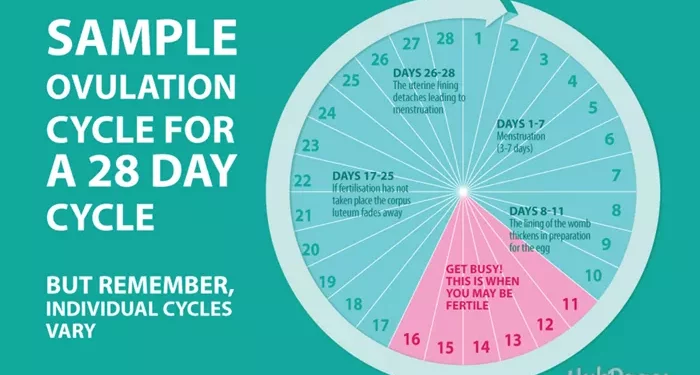Understanding when to check for ovulation is essential for couples trying to conceive. Ovulation is a critical phase in a woman’s menstrual cycle when an egg is released from the ovary, making it available for fertilization by sperm. Knowing the best time to check for ovulation can significantly enhance the chances of conception. This article will explore various methods for tracking ovulation, the signs and symptoms to look for, and provide practical advice on the timing and techniques for accurate ovulation detection.
Understanding the Menstrual Cycle
The menstrual cycle is divided into several phases: the menstrual phase, the follicular phase, ovulation, and the luteal phase. Each phase plays a vital role in the process of ovulation and potential conception.
Menstrual Phase: This is the first phase of the cycle, starting on the first day of menstruation and lasting for about 3 to 7 days.
Follicular Phase: This phase starts on the first day of menstruation and lasts until ovulation. It involves the growth and maturation of ovarian follicles.
Ovulation: This is the release of a mature egg from the ovary, typically occurring around the midpoint of the cycle.
Luteal Phase: This phase follows ovulation and lasts until the onset of menstruation. It involves the preparation of the uterine lining for potential implantation of a fertilized egg.
Why is Timing Ovulation Important?
Timing ovulation accurately is crucial for couples trying to conceive because the fertile window, the period during which pregnancy is most likely to occur, is relatively short. The fertile window includes the day of ovulation and the five days preceding it. Sperm can survive in the female reproductive tract for up to five days, but an egg remains viable for only about 12 to 24 hours after ovulation. Therefore, identifying and targeting this window increases the likelihood of successful fertilization.
Methods for Detecting Ovulation
There are several methods to detect ovulation, each with its own advantages and limitations. These methods include:
- Basal Body Temperature (BBT) Charting
- Ovulation Predictor Kits (OPKs)
- Cervical Mucus Monitoring
- Calendar Method
- Ultrasound Monitoring
- Hormonal Blood Tests
- Saliva Ferning Patterns
Basal Body Temperature (BBT) Charting
BBT charting involves measuring and recording your basal body temperature every morning before getting out of bed. A woman’s BBT typically rises slightly after ovulation due to an increase in the hormone progesterone. By tracking these temperature changes over several cycles, you can identify the pattern of ovulation.
Advantages:
- Inexpensive and easy to do at home.
- Helps in understanding your cycle patterns over time.
Limitations:
- Requires daily commitment and consistency.
- Temperature can be influenced by various factors like illness, stress, or disrupted sleep.
Ovulation Predictor Kits (OPKs)
OPKs detect the surge in luteinizing hormone (LH) that occurs 24 to 36 hours before ovulation. These kits are available over the counter and are simple to use.
Advantages:
- Easy to use and interpret.
- Provides a clear indication of the LH surge, which precedes ovulation.
Limitations:
- Can be expensive if used over several cycles.
- May not be accurate for women with irregular cycles or certain medical conditions.
Cervical Mucus Monitoring
Observing changes in cervical mucus can also help predict ovulation. Around ovulation, cervical mucus becomes clear, stretchy, and slippery, resembling raw egg whites. This change facilitates the movement of sperm through the cervix.
Advantages:
- Inexpensive and can be done at home.
- Helps you become more attuned to your body’s natural signals.
Limitations:
- Requires practice and familiarity with your body.
- Changes can be subtle and influenced by factors such as infections or medications.
Calendar Method
The calendar method involves tracking your menstrual cycle on a calendar to predict ovulation based on previous cycle lengths. Typically, ovulation occurs around day 14 of a 28-day cycle, but this can vary.
Advantages:
- Simple and no cost involved.
- Useful for women with regular, predictable cycles.
Limitations:
- Less accurate for women with irregular cycles.
- Does not account for natural cycle variations.
Ultrasound Monitoring
Transvaginal ultrasound monitoring is a medical procedure where a healthcare provider uses ultrasound to observe the development of ovarian follicles. This method is highly accurate in detecting the exact time of ovulation.
Advantages:
- Highly accurate and reliable.
- Provides detailed information on follicle development.
Limitations:
- Requires frequent visits to a healthcare provider.
- Can be expensive and not easily accessible.
Hormonal Blood Tests
Blood tests can measure hormone levels, such as LH, estradiol, and progesterone, to predict and confirm ovulation. These tests are usually conducted by a healthcare provider.
Advantages:
- Accurate and can provide comprehensive hormonal insights.
- Useful for women with irregular cycles or underlying conditions.
Limitations:
- Requires blood draws and lab work.
- Can be costly and inconvenient.
Saliva Ferning Patterns
Saliva ferning is a less common method that involves observing a pattern in dried saliva. As ovulation approaches, the crystallization pattern in saliva changes to a fern-like structure due to increased estrogen levels.
Advantages:
- Non-invasive and can be done at home.
- Reusable test device.
Limitations:
- Requires practice and a good quality microscope.
- Patterns can be difficult to interpret.
Signs and Symptoms of Ovulation
In addition to using these methods, being aware of the physical signs and symptoms of ovulation can be helpful. Common signs include:
- Mid-Cycle Pain: Some women experience a mild pain or cramping on one side of the abdomen, known as mittelschmerz.
- Increased Libido: Many women notice an increase in sexual desire around the time of ovulation.
- Breast Tenderness: Hormonal changes can cause breast tenderness or sensitivity.
- Bloating: Some women experience bloating due to hormonal fluctuations.
- Heightened Sense of Smell: Sensitivity to smells can increase around ovulation.
Combining Methods for Better Accuracy
For many women, using a combination of methods provides the most accurate and reliable results. For instance, you might use OPKs to detect the LH surge and confirm this with BBT charting or cervical mucus monitoring. Combining methods can help to cross-verify the timing of ovulation and increase confidence in identifying the fertile window.
Timing Intercourse for Conception
Once you have identified your fertile window, timing intercourse appropriately is key to maximizing your chances of conception. Engaging in sexual intercourse during the five days leading up to ovulation and on the day of ovulation provides the best opportunity for sperm to meet the egg.
Frequency of Intercourse
While timing is important, the frequency of intercourse also plays a role. For optimal results, it is recommended to have intercourse every 1 to 2 days during the fertile window. This ensures a healthy supply of sperm is present in the reproductive tract, ready to fertilize the egg.
Understanding Cycle Variations
It’s important to recognize that menstrual cycles can vary from woman to woman and even from month to month in the same woman. Stress, illness, travel, and lifestyle changes can all influence cycle length and ovulation timing. Being flexible and patient is crucial when tracking ovulation.
Seeking Professional Help
If you have been trying to conceive for a year or more without success (or six months if you are over 35), it may be time to seek help from a fertility specialist. A specialist can perform a thorough evaluation to identify any underlying issues and recommend appropriate treatments or interventions.
Conclusion
Determining the best time to check for ovulation involves understanding your menstrual cycle, recognizing the signs and symptoms of ovulation, and using one or more detection methods. By accurately identifying your fertile window, you can significantly improve your chances of conception. Each woman’s body is unique, so finding the right combination of methods and approaches that work for you is essential. Remember to be patient and persistent, and seek professional advice if needed. The journey to conception can be challenging, but with the right information and support, you can increase your chances of success.
Related Links:
Fertility Blood Tests for Women: Things You Need To Know



























